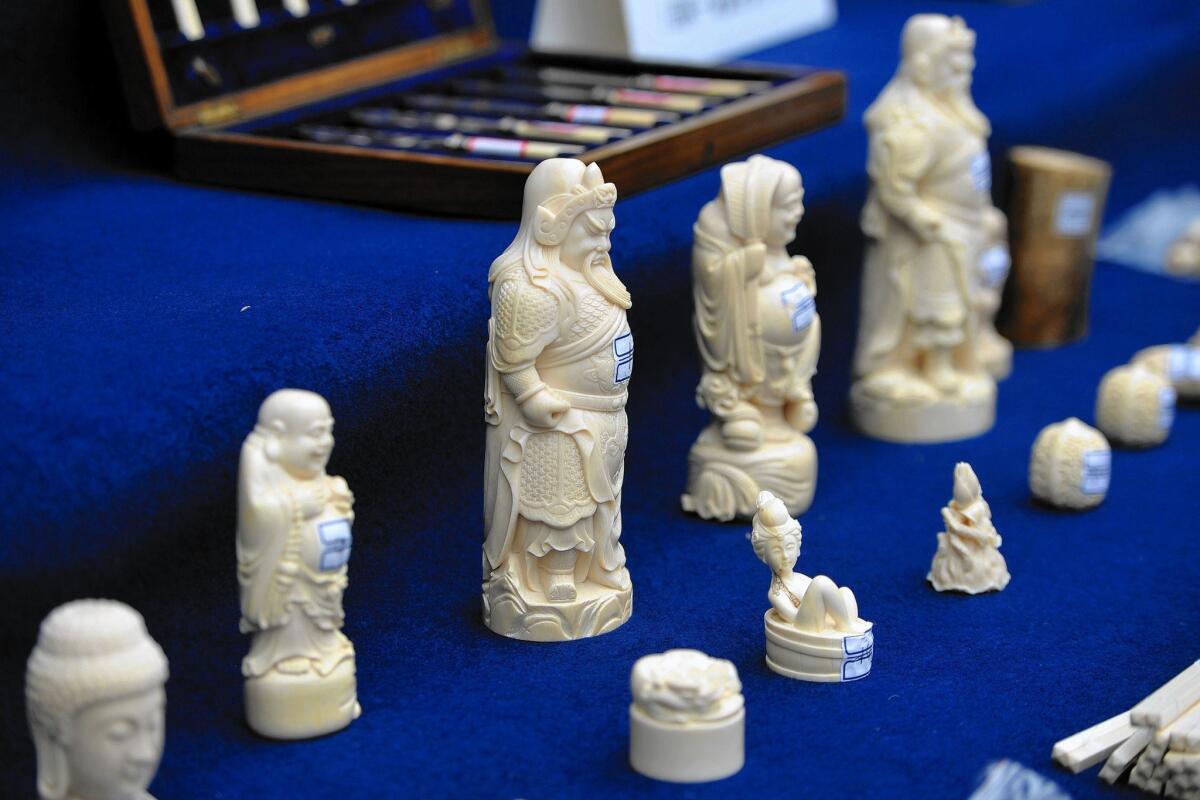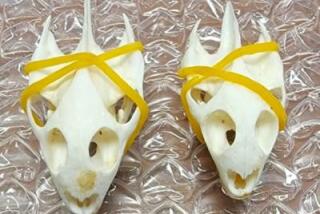China-U.S. ivory ban offers hope of saving elephants but terms unclear

These carved pieces were among illegally imported ivory products confiscated last year by police in Kunming, in southern China’s Yunnan province.
- Share via
Reporting from Beijing — What will it take to save the elephants?
Wildlife organizations have doubled down on the question since Sept. 25, when China and the United States agreed to ban commercial ivory sales in both countries, according to a statement by the White House.
Although many have welcomed the announcement, they have raised questions about the exact terms of the ban, the timeline for implementation and the possible persistence of loopholes that could continue to enable the trade.
“In 2009, when China legalized the import of [some] ivory, poaching started to go up dramatically across Africa,” said Peter Knights, the executive director of WildAid. “What we think is that the sales ban will hopefully have a equal effect in reducing that poaching.”
The Chinese middle and upper classes’ penchant for ivory jewelry, art products and ornamental carvings could drive many countries’ wild elephant populations to extinction, experts say. Tens of thousands of elephants are killed every year for their tusks, according to the Born Free Foundation, a wildlife organization. Mainland China is widely considered to be the world’s biggest ivory consumer; the U.S. ranks second.
China is a signatory to the Convention on International Trade in Endangered Species of Wild Fauna and Flora, or CITES, an international treaty to protect species from extinction due to the wildlife trade. In 1989, the convention declared the African elephant an endangered species, essentially banning the international commercial trade in its tusks.
Yet in 2008, CITES made an exception, permitting China to purchase 62 tons of stockpiled ivory from Botswana, South Africa, Namibia and Zimbabwe. It imported the ivory in 2009 and has distributed a certain amount each year to government-sanctioned carving factories.
China’s demand for ivory has exploded in recent years, as the country’s middle class has swelled. The wholesale price of raw elephant tusks more than doubled from 2010 to 2014, according to the nonprofit group Save the Elephants.
“The United States and China commit to enact nearly complete bans on ivory import and export, including significant and timely restrictions on the import of ivory as hunting trophies, and to take significant and timely steps to halt the domestic commercial trade of ivory,” the White House announced last month after a series of meetings between Chinese President Xi Jinping and President Obama.
The two countries will cooperate in “joint training, technical exchanges, information sharing, and public education on combating wildlife trafficking, and enhance international law enforcement cooperation in this field,” the statement said, without giving a timeline for implementation.
Chinese state media widely reported the announcement, without providing further details.
Experts predict that the ban will close some important loopholes, but probably fall short of eliminating the trade in one fell swoop.
“I feel this is a political decision, but it is definitely a step in the right direction,” said Grace Gabriel, Asia regional director for the International Fund for Animal Welfare. “This is something that we have been trying to do for maybe a decade, to get this issue to the highest level of government, for President Xi Jinping to realize how damaging [the ivory trade] is to China’s international reputation, and the role that China has been playing in this crisis.
“What this needs to have is a concrete implementation plan. The way I see it is, in the market in China, the illegal ivory trade has long eclipsed the legal trade.”
The nonprofit group Environmental Investigation Agency estimates that as much as 90% of mainland China’s ivory is from smuggled tusks.
Gabriel said that licensed ivory sellers often use legal products to “launder” smuggled, poached ivory. In 2013, a court in the southeastern province of Fujian sentenced a licensed ivory dealer to 15 years in prison for illegally importing 7.7 tons of ivory into China over a six-month period in 2011.
“Because the law is so ambiguous, people don’t know what is legal and illegal,” said Gabriel. “Some places you buy are legal, some places are illegal. And everybody is so confused.”
Experts say that one potential snag is the lack of an equivalent ban in Hong Kong. The bustling port city, which is technically controlled by Beijing but maintains an independent legal system, is a notoriously weak link in the international enforcement of wildlife laws.
Sharon Kwok, a wildlife activist at the AquaMeridian Conservation and Education Foundation in Hong Kong, said the city’s ivory trade is still alive and well. Hong Kong maintains government-registered stockpiles of ivory predating the1989 global ban on the ivory trade and allows them to be sold for domestic use in the city.
Traders and merchants, she says, tend to mix legal and illegal ivory, new and old, to disguise its source.
“The main buyers are still from the mainland,” she said. “And it’s still going on, they’re still managing to get stuff in and out of Hong Kong.”
Hong Kong wildlife activists have applied public pressure on Hong Kong retailers to stop selling ivory, she said, and have succeeded in persuading four major department stores to remove all ivory products from their shelves.
“In Hong Kong, [ivory sales] have been going down steadily, but not in a big way — in a very subtle way,” she said. “What’s weird is although the largest retailers have closed shop … there’s been an increase in smaller shops. So the Hong Kong Agriculture, Fisheries and Conservation Department has issued new licenses for new shops.”
In May, Beijing destroyed 1,500 pounds of confiscated elephant tusks and ivory carvings, marking the country’s third such effort in a year and a half and eliciting praise from international environmental groups. Hong Kong began destroying a 28-ton stockpile of confiscated ivory in the spring.
More to Read
Sign up for Essential California
The most important California stories and recommendations in your inbox every morning.
You may occasionally receive promotional content from the Los Angeles Times.










